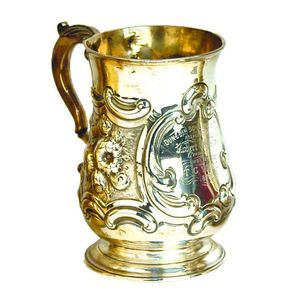Victorian Majolica Stork Pitcher
You must be a subscriber, and be logged in to view price and dealer details.
Subscribe Now to view actual auction price for this item
When you subscribe, you have the option of setting the currency in which to display prices to $Au, $US, $NZ or Stg.
- Victorian Period - The Victorian period of furniture and decorative arts design covers the reign of Queen Victoria from 1837 to 1901. There was not one dominant style of furniture in the Victorian period. Designers used and modified many historical styles such as Gothic, Tudor, Elizabethan, English Rococo, Neoclassical and others, although use of some styles, such as English Rococo and Gothic tended to dominate the furniture manufacture of the period.
The Victorian period was preceded by the Regency and William IV periods, and followed by the Edwardian period, named for Edward VII (1841 ? 1910) who was King of the United Kingdom and the British Dominions and Emperor of India for the brief period from 1901 until his death in 1910. - Circa - A Latin term meaning 'about', often used in the antique trade to give an approximate date for the piece, usually considered to be five years on either side of the circa year. Thus, circa 1900 means the piece was made about 1900, probably between 1895 and 1905. The expression is sometimes abbreviated to c.1900.
- Manner of .... / Style of ..... - A cataloguing term where the item, in the opinion of the cataloguer is a work in the style of the artist, craftsman or designer, possibly of a later period.
- Ewer / Pitcher - A type of jug with a narrow neck bulbous body and wide spout, originally used for carrying and storing liquids such as water or wine. In medieval times they were the source of water to wash ones hands during and after a meal. later the shape was used for vessels in silver, gold, glass and ceramics.
In Victorian times they were made in ceramics and occasionally glass with a matching basin, and sometimes other accessories such as a soap holder or toothbrush holder. Their purpose was to provide facilities for personal washing In the early 19th century were often enclosed in purpose built stands, and later resided on a washstand..
Sometimes the words "ewer" and "pitcher" are used interchangably, but a pitcher is generally considered to be a jug, and would have a wide mouth, and a gently tapering body.
This item has been included into following indexes:
Visually similar items

A Victorian silver baluster mug, heavy embossed C-scroll panelled borders enclosing florals and central cartouche presentation engraved 'Dunedin Bowling Club Presented by Robert Wilson (President) won by T.C. Young 1879', double scroll handle with acanthus

John Campbell green, blue yellow & Rust drip glaze jug with a two ring handle & a slender ribbed body, etched 'F.J.2. John Campbell Tasmania'. Condition good, expected age related wear & crazing. Height 26 cm

A Royal Worcester Sabrina ware 'Fish' decorated vase, circa 1925, painted by W. H. Austin, impressed and inscribed Royal Worcester Made in England, Sabrina Ware, shape 2195, 20.5 cm high

1977 Centenart Test: Bendigo Pottery character jug with heads of Tony Greig & Greg Chappell, limited edition No.98, 17 cm tall
